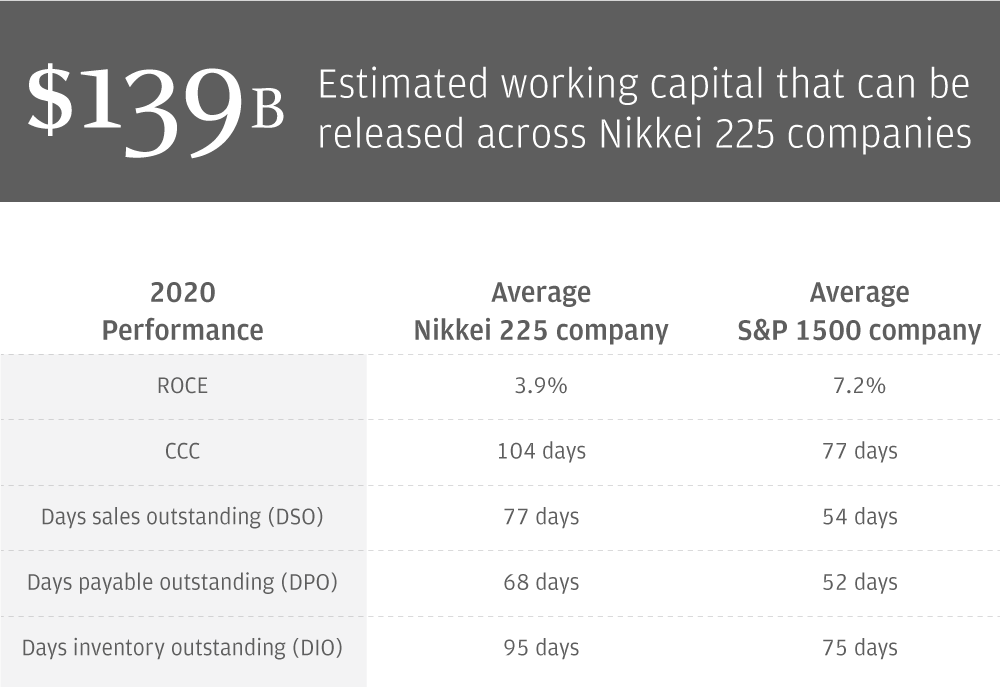
In this report, we examine how Japanese listed firms have fared in their working capital management over the years and how enhancing treasury management can improve both the profitability and balance sheet efficiency to help them generate more value for their shareholders.
The report examines the return on capital employed (ROCE) performances over the past five years, and captures trends from the Working Capital Index, Cash Index and Cash Conversion Cycles (CCC) of the Nikkei 225 companies compared to their S&P 1500 counterparts from 2011 to 2020.
What is return on capital employed?
Return On Capital Employed (ROCE) measures a company’s ability to generate profits on the capital deployed in the business and it has two major components: operating income and capital employed. ROCE is calculated as follows:
ROCE = EBIT(1-tax) / (Average total debt of last two calendar years + Average book value of equity of last two calendar years)
What is a cash conversion cycle?
Cash Conversion Cycle (CCC) helps in quantifying how efficiently a company is managing its working capital. It measures the amount of time it takes to convert inventory purchases into cash flows. CCC is represented as:

The cash conversion cycle (CCC) is the number of days it takes to convert inventory purchases into cash flows from sales. The CCC is a metric that helps quantify the working capital efficiency of a company and is derived from three different components:
- Days Sales Outstanding (DSO) or the number of days taken to collect cash from customers
- Days Inventory Outstanding (DIO) or the number of days the company holds its inventory before selling it
- Days Payable Outstanding (DPO) or the number of days from the time a company procures raw materials to payment to suppliers
Key takeaways at a glance

Improvements to cash and working capital levels can significantly boost the ROCE of Nikkei 225 companies by 0.8 percent.
Treasury can help improve ROCE for Japanese companies by focusing on three key pillars:
- Establishing a globally integrated and centralized treasury
- Embracing digitization to automate processes
- Optimizing liquidity and working capital to free up trapped cash
To learn more about benchmarking and optimizing global working capital, please contact your J.P. Morgan representative.
Investments or strategies discussed herein may not be suitable for all investors. Neither J.P. Morgan nor any of its directors, officers, employees or agents shall incur in any responsibility or liability whatsoever to the Company or any other party with respect to the contents of any matters referred herein, or discussed as a result of, this material. This material is not intended to provide, and should not be relied on for, accounting, legal or tax advice or investment recommendations. Please consult your own tax, legal, accounting or investment advisor concerning such matters.
The views and opinions expressed herein are those of the author and do not necessarily reflect the views of J.P. Morgan, its affiliates, or its employees. The information set forth herein has been obtained or derived from sources believed to be reliable. Neither the author nor J.P. Morgan makes any representations or warranties as to the information’s accuracy or completeness. The information contained herein has been provided solely for informational purposes and does not constitute an offer, solicitation, advice or recommendation, to make any investment decisions or purchase any financial instruments, and may not be construed as such.
JPMorgan Chase Bank, N.A. Member FDIC.
JPMorgan Chase Bank, N.A., organized under the laws of U.S.A. with limited liability.







